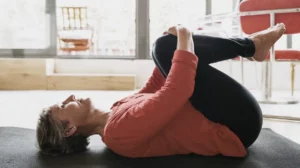As women enter the transitional phase of perimenopause, a myriad of changes unfold in their bodies, and one often overlooked aspect is the impact on bladder health. From increased urgency to changes in frequency, perimenopausal bladder problems can be both frustrating and disruptive. However, understanding these issues and exploring effective treatments can empower women to take control of their well-being. In this blog, we will delve into the nuances of perimenopause-related bladder problems, offering insights, and perimenopause bladder problems treatment to help you navigate this aspect of your health journey.
Contents
Can Perimenopause Cause Bladder Issues?
 Yes, perimenopause can indeed cause bladder issues. Perimenopause is the transitional phase leading up to menopause, marked by hormonal fluctuations, particularly a decline in estrogen levels. Estrogen plays a crucial role in maintaining the health of the urinary system, including the bladder and urethra.
Yes, perimenopause can indeed cause bladder issues. Perimenopause is the transitional phase leading up to menopause, marked by hormonal fluctuations, particularly a decline in estrogen levels. Estrogen plays a crucial role in maintaining the health of the urinary system, including the bladder and urethra.
As estrogen levels decrease during perimenopause, several changes can occur in the genitourinary system that may contribute to bladder issues, such as:
- Decreased Muscle Tone: Estrogen helps maintain the elasticity and strength of the pelvic floor muscles. A decline in estrogen can lead to weakened pelvic floor muscles, potentially causing issues like urinary incontinence and increased frequency of urination.
- Thinning of Urethral Tissues: Estrogen also helps keep the tissues of the urethra healthy and well-lubricated. Lower estrogen levels may result in thinning of these tissues, leading to irritation and increased susceptibility to infections.
- Bladder Contractions: Estrogen influences the coordination of muscle contractions in the bladder. Hormonal changes during perimenopause may disrupt this coordination, leading to an overactive bladder and increased urgency to urinate.
- Urinary Tract Infections (UTIs): Reduced estrogen levels can make the urinary tract more vulnerable to infections. Perimenopausal women may experience an increased risk of UTIs. This can cause symptoms like frequent urination, urgency, and discomfort.
It’s essential for women experiencing bladder issues during perimenopause to seek medical advice. Healthcare professionals can provide a thorough evaluation, offer targeted treatments, and suggest lifestyle modifications to manage these symptoms effectively.
What Are Some Best Perimenopause Bladder Problems Treatment?
Perimenopause bladder problems treatment involves a combination of lifestyle changes, targeted exercises, and, in some cases, medical interventions. Here are some effective perimenopause bladder problems treatment:
Hormone Replacement Therapy (HRT)
Hormone Replacement Therapy involves supplementing the declining levels of estrogen and, if needed, progesterone during perimenopause. Estrogen plays a crucial role in maintaining the health of the urogenital tissues, including those of the bladder. By restoring hormonal balance, HRT can alleviate symptoms such as urinary urgency, frequency, and incontinence. However, it’s important to discuss the potential benefits and risks of HRT with your healthcare provider, as it may not be suitable for everyone.
Dietary Changes
Making mindful dietary choices is integral to managing perimenopausal bladder issues. Certain foods and beverages can irritate the bladder, exacerbating symptoms. Caffeine, found in coffee, tea, and some sodas, is a known bladder irritant that can increase urgency and frequency. Spicy foods and acidic fruits, such as citrus, can also contribute to irritation. Opting for a well-balanced diet that includes fiber-rich foods helps prevent constipation, reducing pressure on the bladder. Staying hydrated with water is essential, but it’s advisable to limit the intake of bladder-irritating substances to mitigate symptoms effectively.
Maintain a Healthy Lifestyle
Maintaining a healthy lifestyle can positively impact perimenopausal bladder problems. One key aspect is managing body weight, as excess weight can contribute to increased pressure on the bladder and pelvic floor muscles. Engaging in regular physical activity is beneficial, with low-impact exercises like walking and swimming being particularly helpful. Exercise not only promotes overall health but also supports weight management and enhances the strength and flexibility of pelvic floor muscles, contributing to better bladder control.
Bladder Training
Bladder training is a behavioral therapy aimed at improving bladder control and reducing urgency. This involves gradually increasing the time between bathroom visits to train the bladder to hold larger volumes of urine. Keeping a bladder diary helps identify patterns of urination and can be a useful tool in developing an individualized bladder training plan. The process requires consistency and patience, as gradual progress is made over time.
Biofeedback
Biofeedback is a therapeutic technique that helps individuals gain voluntary control over physiological processes, such as muscle activity. In the context of perimenopausal bladder problems, biofeedback can be particularly useful for improving control over pelvic floor muscles. During a biofeedback session, sensors are used to monitor muscle activity, providing real-time feedback. This visual or auditory feedback helps individuals understand how to contract and relax pelvic floor muscles effectively. Over time, this increased awareness and control can lead to improved bladder function.
Medications
 Medications may be prescribed to manage specific perimenopausal bladder issues, such as overactive bladder or urinary incontinence. Anticholinergic medications, which help relax the bladder muscle, and beta-3 agonists, which increase bladder capacity, are commonly prescribed. It’s crucial to discuss potential side effects, interactions, and the overall suitability of these medications with your healthcare provider. Additionally, regular follow-up appointments are important to assess the medication’s effectiveness and make any necessary adjustments to the treatment plan.
Medications may be prescribed to manage specific perimenopausal bladder issues, such as overactive bladder or urinary incontinence. Anticholinergic medications, which help relax the bladder muscle, and beta-3 agonists, which increase bladder capacity, are commonly prescribed. It’s crucial to discuss potential side effects, interactions, and the overall suitability of these medications with your healthcare provider. Additionally, regular follow-up appointments are important to assess the medication’s effectiveness and make any necessary adjustments to the treatment plan.
Vaginal Estrogen Therapy
Vaginal estrogen therapy is a localized treatment that can be beneficial for women experiencing vaginal dryness, irritation, or thinning of tissues during perimenopause. This therapy involves the use of estrogen in the form of creams, tablets, or rings directly applied to the vaginal area. By replenishing estrogen levels locally, this therapy helps restore moisture, elasticity, and overall vaginal health. It is important to consult with a healthcare provider to determine the most appropriate form, dosage, and duration.
Alternative Therapies
Some women explore alternative therapies to complement traditional treatments for perimenopausal bladder problems. Acupuncture, an ancient Chinese practice involving the insertion of thin needles into specific points on the body, may help alleviate symptoms. Herbal supplements, such as those containing soy or black cohosh, are sometimes considered for their potential estrogen-like effects. Yoga, with its focus on mindfulness and gentle movements, may contribute to overall well-being. However, it’s crucial to approach alternative therapies with caution and consult with a healthcare professional before incorporating them into your treatment plan to ensure safety.
Overall, these perimenopause bladder problem treatment options provide a diverse range of approaches. A collaborative and individualized approach with healthcare professionals ensures that the chosen treatments align with the specific needs and preferences of each woman experiencing perimenopausal bladder symptoms.
What Are Some Exercises For Perimenopause Bladder Problems?
 Exercise can play a crucial role in managing perimenopause-related bladder problems by strengthening the pelvic floor muscles and improving overall bladder control. Here are some specific exercises that can be beneficial:
Exercise can play a crucial role in managing perimenopause-related bladder problems by strengthening the pelvic floor muscles and improving overall bladder control. Here are some specific exercises that can be beneficial:
Kegel Exercises
Kegel exercises target the pelvic floor muscles, which support the bladder, uterus, and bowel. To perform Kegels:
- Identify the pelvic floor muscles by stopping the flow of urine midstream (do not practice Kegels while urinating).
- Contract these muscles for about 5 seconds, then relax for 5 seconds.
- Gradually increase the duration of contractions as your muscles strengthen.
- Aim for 10-15 repetitions, three times a day.
Bridge Exercise
The bridge exercise engages the pelvic floor and strengthens the core and glute muscles.
- Lie on your back with knees bent and feet hip-width apart.
- Lift your hips towards the ceiling, creating a straight line from shoulders to knees.
- Hold for a few seconds, then lower back down.
- Repeat 10-15 times.
Squats
Squats engage the pelvic floor, thighs, and glutes, promoting overall lower body strength.
- Stand with feet shoulder-width apart.
- Lower your body as if sitting back into a chair, keeping knees over ankles.
- Keep your back straight, and return to the starting position.
- Perform 10-15 repetitions.
Pelvic Tilts
Pelvic tilts target the lower abdominal and pelvic muscles.
- Lie on your back with your knees bent and feet flat on the floor.
- Tighten your abdominal muscles and tilt your pelvis towards your head.
- Hold for a few seconds, then release.
- Repeat 10-15 times.
Flutter Kicks
Flutter kicks engage the lower abdominal and pelvic muscles.
- Lie on your back with your legs extended.
- Lift one leg a few inches off the ground and then switch legs in a fluttering motion.
- Keep your lower back pressed into the floor.
- Perform for 1-2 minutes.
Yoga and Pilates
Both yoga and Pilates incorporate exercises that promote core strength, flexibility, and body awareness. This can be beneficial for perimenopausal bladder problems. Positions like the cat-cow stretch in yoga or pelvic curls in Pilates can engage and strengthen the pelvic floor muscles.
Remember to start slowly, especially if you are new to exercise. Consistency is key, and gradual progression is more effective than overexertion. If you’re unsure about which exercises are suitable for you, consider consulting with a healthcare professional or a physical therapist, particularly one specializing in pelvic floor health, to receive personalized guidance.
Conclusion
In conclusion, perimenopause can bring about changes in bladder function that may impact a woman’s daily life. However, by understanding these challenges and taking proactive steps, women can effectively manage perimenopausal bladder issues. From simple lifestyle adjustments like dietary changes and staying active to targeted exercises such as Kegels and seeking professional guidance for more advanced therapies, a holistic approach is key.
The importance of open communication with healthcare providers, exploring various treatment options, and embracing a healthy lifestyle cannot be overstated. By empowering themselves with knowledge and engaging in proactive self-care, women can navigate perimenopause with confidence. If you are facing menopause-related issues, menopause treatment at HerMantra can help. Book your free trial online menopause treatment session now.


